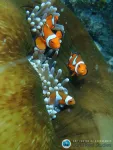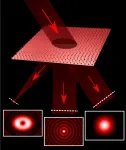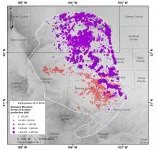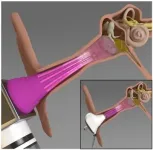Drone tech's next big target: insect pest management
New research collection showcases unmanned aircraft systems' use against mosquitoes, crop pests, and more
2021-06-28
(Press-News.org) Annapolis, MD; June 28, 2021--Drones keep getting smaller and smaller, while their potential applications keep getting bigger and bigger. And now unmanned aircraft systems are taking on some of the world's biggest small problems: insect pests.
From crop-munching caterpillars to disease-transmitting mosquitoes, insects that threaten crops, ecosystems, and public health are increasingly being targeted with new pest-management strategies that deploy unmanned aircraft systems (UAS, or drones) for detection and control. And a variety of these applications are featured in a new special collection published this week in the Journal of Economic Entomology.
"Ten years ago, there was not much happening in the space in terms of entomologists deploying UAS for pest management," says Nathan Moses-Gonzales, CEO of M3 Agriculture Technologies, who compiled the research collection alongside Michael Brewer, Ph.D., professor of field crops entomology with AgriLife Research at Texas A&M University. But, in the time since, technological advances have opened the doors for creative collaborations between entomologists and drone developers, Moses-Gonzales says. "The evolution of UAS technology in entomology has been fascinating to watch."
The collection in the Journal of Economic Entomology, featuring both newly released and recently published research, gathers examples illustrating both the progress and potential of drone technology in insect pest management settings. Case studies include:
Locating and sampling standing water for mosquito larvae and improving accuracy of insecticide applications targeting mosquito larvae and adults.
Applying precise amounts of pheromones via drone over cranberry beds to disrupt the mating of cranberry fruitworms (Acrobasis vaccinii) and blackheaded fireworms (Rhopobota naevana).
Photographing tree canopies from above via drone in winter to survey for presence of cocoons of the moth Monema flavescens and prevent defoliation in the subsequent summer.
Delivering and releasing predator and parasitoid insects via drone to target the European corn borer (Ostrinia nubilalis) and the eastern spruce budworm (Choristoneura fumiferana).
Using drones to release sterile Mexican fruit flies (Anastrepha ludens) and codling moths (Cydia pomonella) to suppress wild populations of the pests--a modern improvement on the classic sterile insect technique.
Several articles in the collection also explore potential future applications for drone technology in insect pest management, including aerial spectral imagery of crops and plants to assess signs of pest damage, enhanced deployment of traps and monitoring systems to detect insects in hard-to-reach locations, and more.
"Our special collection speaks to the uniqueness of these partnerships and demonstrates the vital role entomologists play in bringing concepts to reality through methods development and field testing," Moses-Gonzales says.
Of course, continued research, development, and experimentation will refine drone technology in the pest management context, and research in related fields such as automation and artificial intelligence will be critical, as well. Moses-Gonzales and Brewer say they see a bright future for this multidisciplinary field.
"Here, we hope that the Journal of Economic Entomology will serve as a venue that not only supports rigorous research but also details the development of new and novel tools for use in pest management," Moses-Gonzales says.
INFORMATION:
The ESA special collection "Drones to Improve Insect Pest Management" is available now, featuring 15 research articles published in the Journal of Economic Entomology.
CONTACT: Joe Rominiecki, jrominiecki@entsoc.org, 301-731-4535 x3009
ABOUT: ESA is the largest organization in the world serving the professional and scientific needs of entomologists and people in related disciplines. Founded in 1889, ESA today has more than 7,000 members affiliated with educational institutions, health agencies, private industry, and government. Headquartered in Annapolis, Maryland, the Society stands ready as a non-partisan scientific and educational resource for all insect-related topics. For more information, visit www.entsoc.org.
The Journal of Economic Entomology publishes research on the economic significance of insects and is the most-cited journal in entomology. It includes sections on apiculture and social insects, insecticides, biological control, household and structural insects, crop protection, forest entomology, and more. For more information, visit https://academic.oup.com/jee, or visit www.insectscience.org to view the full portfolio of ESA journals and publications.
[Attachments] See images for this press release:
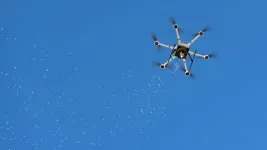
ELSE PRESS RELEASES FROM THIS DATE:
2021-06-28
A new study has found baby coral reef fishes can outpace all other baby fishes in the ocean.
Lead author Adam Downie is a PhD candidate at the ARC Centre of Excellence for Coral Reef Studies at James Cook University (Coral CoE at JCU).
Mr Downie said when considering aquatic athletes, young coral reef fishes shine: they are some of the fastest babies, swimming around 15-40 body lengths per second.
As a comparison, herring babies swim up to two body lengths per second, and the fastest human in the water, Olympic gold medalist Michael Phelps, can only swim 1.4 body lengths ...
2021-06-28
The year 2020 was a period of economic hardship and significant change in a wide range of sectors for most countries. A team of authors from HSE University has explored how Russia will recover from this crisis and which industries will be affected by the economic recovery. Their study was published in the journal Voprosy ekonomiki.
Last year, the global economy experienced a crisis due to the coronavirus pandemic, with output falling by 3.5% compared to 2019. Russia's decline from the coronavirus measures was more moderate than in many developed countries (industrial ...
2021-06-28
Almost all of the nitrogen that fertilizes life in the open ocean of the Gulf of Mexico is carried into the gulf from shallower coastal areas, researchers from Florida State University found.
The work, published in Nature Communications, is crucial to understanding the food web of that ecosystem, which is a spawning ground for several commercially valuable species of fish, including the Atlantic bluefin tuna, which was a focus of the research.
"The open-ocean Gulf of Mexico is important for a lot of reasons," said Michael Stukel, an associate professor in the Department of Earth, ...
2021-06-28
LAWRENCE -- Despite facing cultural and political pushback, the evidence remains clear: Face masks made a difference in Kansas.
"These had a huge effect in counties that had a mask mandate," said Donna Ginther, the Roy A. Roberts Distinguished Professor of Economics and director of the Institute for Policy & Social Research at the University of Kansas. "Our research found that masks reduced cases, hospitalizations and deaths in counties that adopted them by around 60% across the board."
Ginther's article "Association of Mask Mandates and COVID-19 ...
2021-06-28
Washington, DC--Location, location, location--when it comes to the placement of wind turbines, the old real estate adage applies, according to new research published in Proceedings of the National Academy of Sciences by Carnegie's Enrico Antonini and Ken Caldeira.
Turbines convert the wind's kinetic energy into electrical energy as they turn. However, the very act of installing turbines affects our ability to harness the wind's power. As a turbine engages with the wind, it affects it. One turbine's extraction of energy from the wind influences the ability of its neighbors to do the same.
"Wind is never going to 'run dry' as an energy resource, but our ability to harvest it isn't infinitely scalable either," Antonini explained. "When wind turbines ...
2021-06-28
The ability to precisely control the various properties of laser light is critical to much of the technology that we use today, from commercial virtual reality (VR) headsets to microscopic imaging for biomedical research. Many of today's laser systems rely on separate, rotating components to control the wavelength, shape and power of a laser beam, making these devices bulky and difficult to maintain.
Now, researchers at the Harvard John A. Paulson School of Engineering and Applied Sciences have developed a single metasurface that can effectively tune the different properties of laser light, ...
2021-06-28
In the context of recent debate over the FDA's approval of aducanumab, it's refreshing to learn about a model of Alzheimer's neurodegeneration that doesn't start with the pathogenic proteins amyloid or Tau.
A new paper in Alzheimer's & Dementia from Emory neuroscientist Shan Ping Yu and colleagues focuses on an unusual member of the family of NMDA receptors, signaling molecules that are critical for learning and memory. Their findings contain leads for additional research on Alzheimer's, including drugs that are already FDA-approved that could be used preventively, and genes ...
2021-06-28
Deployable structures -- objects that transition from a compact state to an expanded one -- are used everywhere from backyards to Mars. But as anyone who has ever struggled to open an uncooperative folding chair knows, transforming two-dimensional forms into three-dimensional structures is sometimes a challenge.
Now, researchers from the Harvard John A. Paulson School of Engineering and Applied Sciences (SEAS) and the Harvard Graduate School of Design have developed a deployable system that is light, compact, inexpensive, easy to manufacture, and, most importantly, easy to deploy. By harnessing the mechanical instabilities in curved beams, the system can transform objects into elaborate and customizable 3D configurations on a range of scales, from large-scale furniture to small medical ...
2021-06-28
Boulder, Colo., USA: Subsurface carbon sequestration--storing carbon in
rocks deep underground--offers a partial solution for removing carbon from
the atmosphere. Used alongside emissions reductions, geologic carbon
sequestration could help mitigate anthropogenic climate change. But like
other underground operations, it comes with risks--including earthquakes.
Geophysicists are still working to understand what can trigger
human-induced earthquakes, which have been documented since the 1960s. A
new study, published in Geology on Thursday, explores why part of
a heavily produced oilfield in the U.S. has ...
2021-06-28
Middle ear infections, also known as otitis media, affect more than 80% of the children in the U.S. In a new study, researchers have designed a miniaturized 3D-printed device to inactivate Pseudomonas aeruginosa, a common bacterium that causes the infection.
The device--a microplasma jet array--generates plasma, which is composed of charged particles and reactive molecules that have been previously shown to inactivate various pathogens. "This is the first time anyone has tried treating middle ear infections using plasma technology," said Jungeun Won, a graduate student in the Boppart lab. "Usually, the treatment involves using ...
LAST 30 PRESS RELEASES:
[Press-News.org] Drone tech's next big target: insect pest management
New research collection showcases unmanned aircraft systems' use against mosquitoes, crop pests, and more

